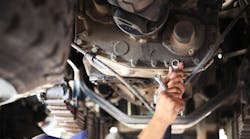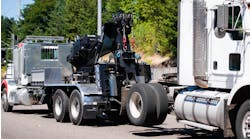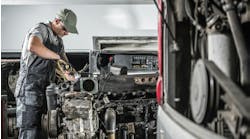Editor’s note: This is the second part of a series looking at maintenance decisions. Read part one here.
Greg Hart is owner of Hart & Hart Consulting and interim vice president of maintenance at Smith Transport, a Roaring Spring, PA-based truckload carrier with 780 tractors and 2,200 dry vans.
Hart said that cost is ultimately the sole driver behind the decision whether to perform maintenance in-house or outsource the service. And that, in turn, depends somewhat on fleet size.
“For most fleets, the fully burdened cost of in-house maintenance, including overhead, insurance, pay and bonuses is lower than the cost for outside service,” Hart said. “If you operate 10 to 20 trucks outsourcing may be the right choice and for fleets with up to 100 trucks it might be difficult to compete for technicians, so having a good provider might have value. For larger fleets, though, in-house operations probably make the most sense from a cost standpoint.”
One plus for in-house maintenance is that it generally leads to fewer unscheduled issues, according to Jarit Cornelius, vice president of asset maintenance & compliance at Sharp Transport Inc.
“We have good partnerships with vendors for things like engine warranty repairs and for on-site preventive maintenance at some of our locations that are not large enough for a brick-and-mortar set up,” said Cornelius, whose truckload carrier is based in Ethridge, TN, and operates 137 trucks and 370 trailers. “At the same time, we have our own mobile service trucks that handle PMs on trailers where they are located, and that lowers costs and improves quality because we can train our own technicians in our best practices.”
Another factor, Cornelius noted, are hours-of-service rules for truck drivers.
“All of our drivers know we will do everything we can to schedule maintenance during their rest breaks so they can use available hours to make money hauling freight,” he said. “And that’s easier when we have the work done by our technicians and in our facility.”
In the tank truck sector, the customer base has high expectations and requirements, so most maintenance is completed in-house, said Brian Gigoux, vice president of equipment & maintenance at Groendyke Transport.
Groendyke, based in Enid, OK, is one of the largest tank truck carriers in the country with 880 tractors and 1,450 trailers. The company has 38 full-service maintenance facilities in 14 states.
“We do all scheduled PM in-house with about 120 technicians plus a management structure that includes shop managers and lead technicians,” Gigoux said. “Almost two-thirds of our labor hours are on trailers because of the complexity of our equipment. We also feel that we can be more proactive in-house when it comes to things like brakes, lights and tires.”
Gigoux added the company considers labor rates for different regions and compares them with in-house costs using a maintenance database and VMRS codes. He also said that driver satisfaction and waiting times at service providers are taken into account, especially when it comes to shorter wait times for PM or unscheduled repairs.
Bryan Stewart, director of maintenance at Jones Logistics, Hattiesburg, MS, said the company recently closed its shops and moved work to third-party providers.
“We were not unhappy doing maintenance in-house. Our business just moved to different parts of the country so we didn’t want to invest in starting up shops in other locations,” said Stewart.
Jones Logistics runs 98 tractors and 578 van, flatbed, step deck, mini-deck and double drop trailers.
“We understand the value of the in-house model, but technician training and tooling investments that are required are rapidly closing the gap in cost between in-house or third-party operations,” Stewart continued. “As recently as last year we did about 80% of our work in-house, and because we measure costs regularly, we knew that overhead, tooling, technician training and pay were to the point that we were getting closer to what service providers charge.
He added: “Once we eliminated our shops, even with higher service provider rates, we realized that our costs stayed about the same. We attributed that to non-productive technician time from keeping technicians on staff for convenience, and while we did all we could to minimize that, it still added up.”
Jones Logistics works with many providers nationwide, and “the secret is getting to know what they can provide and making them understand our needs,” Stewart said. “The time and effort that takes is worth it. While we enjoy having a low-cost point, we will not compromise on quality of service and value because it never pays.”
Coming Wednesday: A look at additional factors that should be considered when deciding whether to handle maintenance in-house or outsource.



